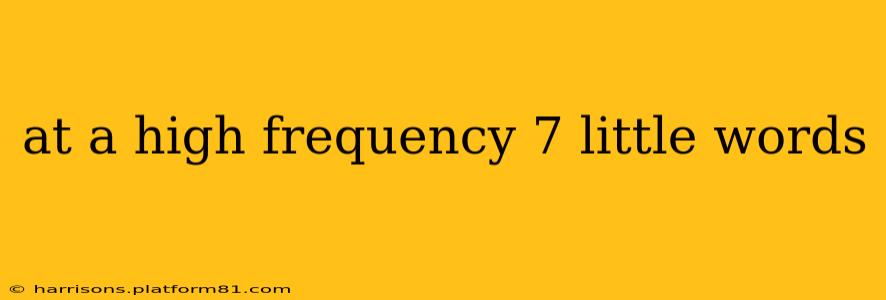At a High Frequency: Decoding the Meaning and Applications
The phrase "at a high frequency" suggests something happening repeatedly and rapidly. But what does it really mean, and where do we encounter this concept in everyday life and specialized fields? This article dives deep into the meaning, explores various applications, and answers some frequently asked questions.
What does "at a high frequency" mean?
Simply put, "at a high frequency" means occurring many times within a short period. The term "frequency" refers to how often something happens within a given unit of time, usually measured in Hertz (Hz), which represents cycles per second. A high frequency, therefore, implies a large number of cycles or occurrences per second, or per minute, or per hour—depending on the context.
What are some examples of high-frequency occurrences?
The application of "high frequency" depends heavily on context. Here are a few examples:
- Sound: High-frequency sounds are those with a high pitch, like a whistle or a high note on a violin. These sounds have many vibrations per second.
- Electromagnetic waves: Radio waves, microwaves, infrared radiation, visible light, ultraviolet radiation, X-rays, and gamma rays are all types of electromagnetic radiation that travel at a high frequency. The frequency determines the type of radiation.
- Trading: High-frequency trading (HFT) in finance involves executing a large number of trades within a very short time frame, often using sophisticated algorithms.
- Data processing: High-frequency data processing refers to the rapid handling and analysis of large amounts of data, crucial in areas like real-time analytics and artificial intelligence.
- Mechanical vibrations: High-frequency vibrations can be felt as shaking or buzzing, and can occur in machines, engines, or even in the ground during an earthquake.
How is high frequency measured?
The measurement unit for frequency is Hertz (Hz), which is one cycle per second. Kilohertz (kHz) represents thousands of Hertz, Megahertz (MHz) millions, and Gigahertz (GHz) billions. The specific unit used depends on the magnitude of the frequency being measured. For example, radio waves are measured in MHz or GHz, while sound waves are measured in Hz or kHz.
What are the effects of high frequency?
The effects of high frequency vary depending on the context. In sound, high-frequency sounds can be perceived as shrill or piercing. In electromagnetic radiation, high-frequency radiation like X-rays and gamma rays has higher energy and can be harmful to living tissue. In trading, high-frequency trading can lead to increased market volatility. In data processing, high-frequency processing allows for real-time insights and responses.
What is the difference between high frequency and low frequency?
The difference lies primarily in the number of cycles or occurrences per unit of time. Low-frequency events occur less often, while high-frequency events occur frequently. For instance, a low-frequency sound would have a low pitch, while a high-frequency sound would have a high pitch. Similarly, low-frequency trading would involve fewer trades over a longer period compared to high-frequency trading.
Can high frequency be harmful?
Whether high frequency is harmful depends entirely on the context. High-frequency sound can cause hearing damage at sufficiently high intensities. Similarly, high-frequency electromagnetic radiation can be damaging to biological tissues. However, many high-frequency phenomena are not inherently harmful; high-frequency data processing, for instance, is beneficial. The potential harm depends on the type of frequency and its intensity.
This exploration of "at a high frequency" demonstrates the broad application of the term across diverse scientific and technological domains. Understanding its meaning and implications is crucial for navigating these complex areas effectively.
